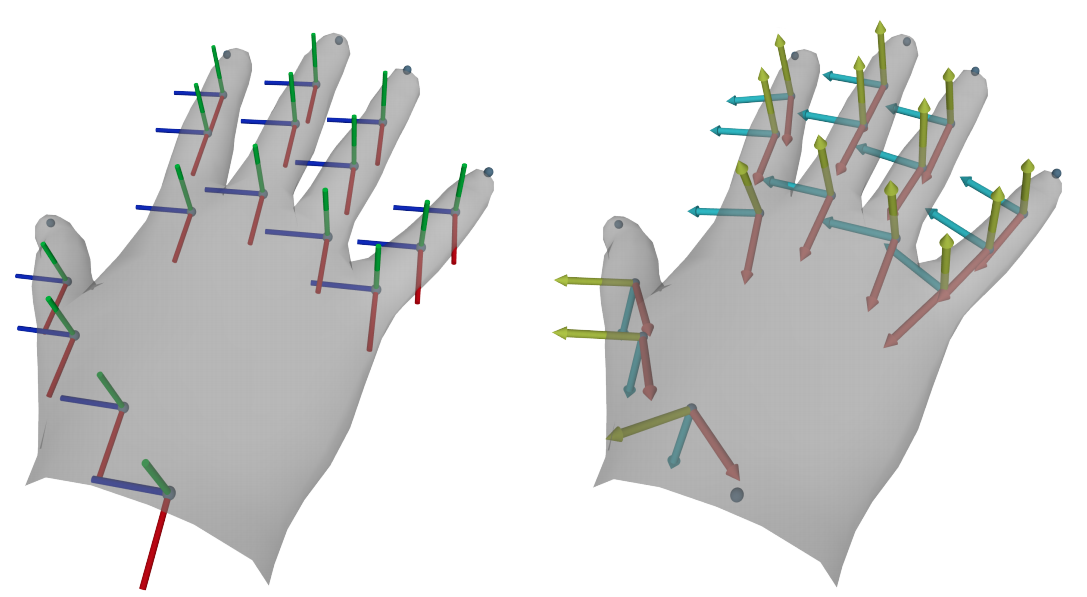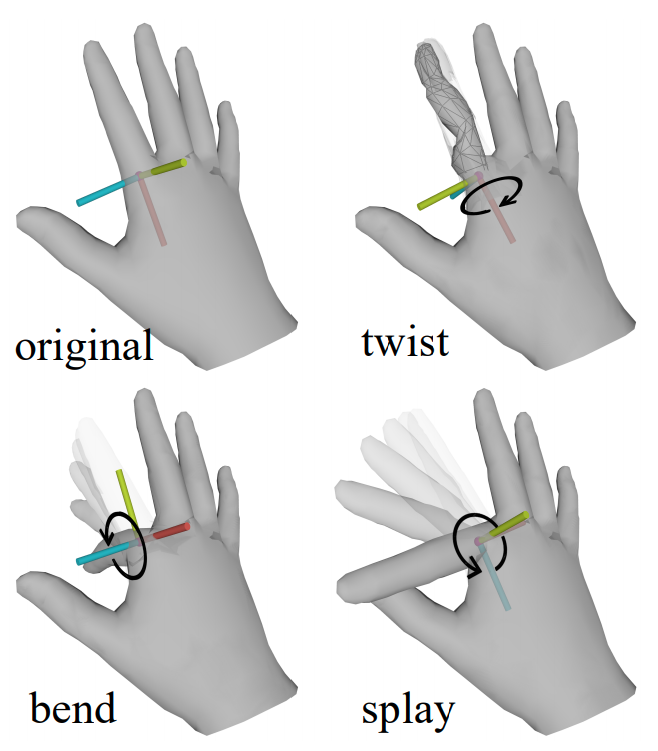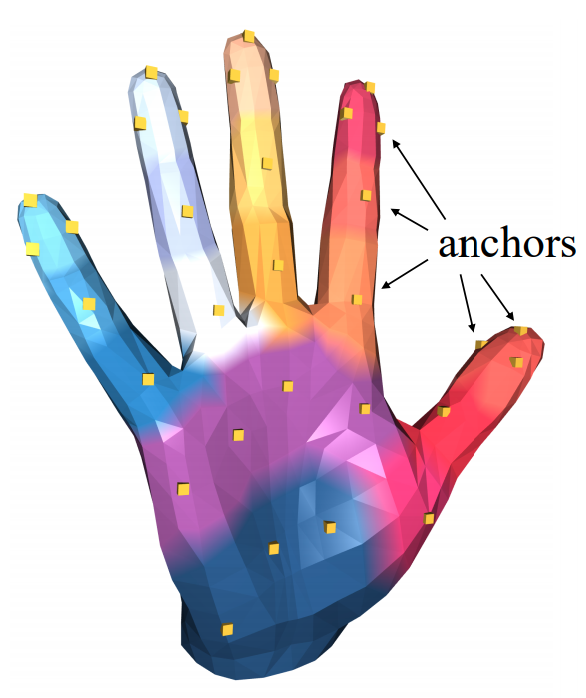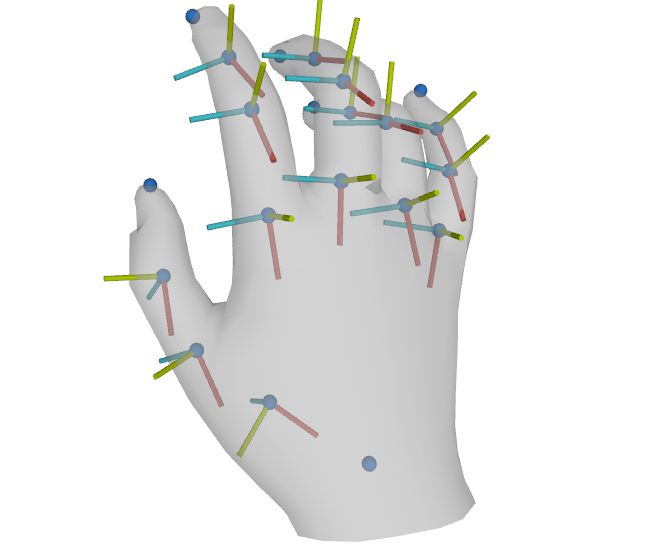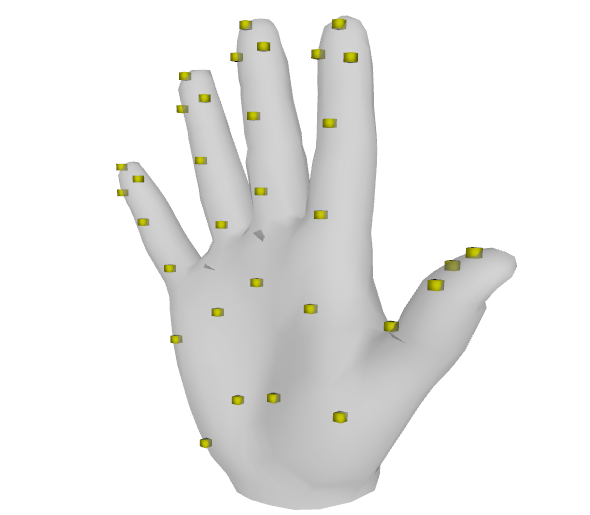ManoLayer is a differentiable PyTorch layer that deterministically maps from pose and shape parameters to hand joints and vertices. It can be integrated into any architecture as a differentiable layer to predict hand meshes.
This MANO layer is modified from the original manopth with following features.
- Additional axes adaptation to covert MANO's coordinate frame into a twist-splay-bend frame based on hand anatomy (axislayer.py).
Left: original MANO coordinate system; Middle: axes adaptation; Right: rotation based on the axes adaptation
- Additional anchor interpolation to derive the anchor representation of MANO's vertices on palm (anchorlayer).
-
Quaternion rotation mode. (quatutils.py)
-
Ortho6D rotation mode.
-
Employ lietorch to perform
exp()in SO(3) group. (once lietorch supports backward of ToMatrix operation).
The first two features were developed and used for the paper CPF: Learning a Contact Potential Field to Model the Hand-object Interaction. But we find it also useful in researches including:
- avoid hand pose abnormality during learning or fitting by applying anatomically constraints on rotation axes and angles.
- derive a coarse palm vertices representation to treat contact during hand-object interaction.
If you find this code useful for your research, consider citing:
- the publication of the repository was used for
@article{yang2020cpf,
title={CPF: Learning a Contact Potential Field to Model the Hand-object Interaction},
author={Yang, Lixin and Zhan, Xinyu and Li, Kailin and Xu, Wenqiang and Li, Jiefeng and Lu, Cewu},
journal={arXiv preprint arXiv:2012.00924},
year={2020}
}
- the original MANO publication:
@article{MANO:SIGGRAPHASIA:2017,
title = {Embodied Hands: Modeling and Capturing Hands and Bodies Together},
author = {Romero, Javier and Tzionas, Dimitrios and Black, Michael J.},
journal = {ACM Transactions on Graphics, (Proc. SIGGRAPH Asia)},
publisher = {ACM},
month = nov,
year = {2017},
url = {http://doi.acm.org/10.1145/3130800.3130883},
month_numeric = {11}
}
$ git clone https://github.com/lixiny/manotorch.git
$ cd manotorchInstall the dependencies listed in environment.yaml
# In a new environment,
$ conda env create -f environment.yaml
# Or in an existing conda environment,
$ conda env update -f environment.yamlFor user in China, we provide an alternative environment_tuna.yaml based on Tuna Mirror of Tsinghua University
- Visit MANO website
- Create an account by clicking Sign Up and provide your information
- Download Models and Code (the downloaded file should have the format
mano_v*_*.zip). Note that all code and data from this download falls under the MANO license. - unzip and copy the contents in
mano_v*_*/folder to theassets/mano/folder - Your
assets/manofolder structure should look like this:
assets/mano
├── info.txt
├── __init__.py
├── LICENSE.txt
├── models
│ ├── info.txt
│ ├── LICENSE.txt
│ ├── MANO_LEFT.pkl
│ ├── MANO_RIGHT.pkl
│ ├── SMPLH_female.pkl
│ └── SMPLH_male.pkl
└── webuser
└── ...
To be able to import and use manotorch in another project, go to your manotorch folder and run
$ pip install .
# Or,
$ pip install -e .
we provide a simple code snippet to demonstrate the minimal usage.
import torch
from manotorch.manolayer import ManoLayer
from manotorch.axislayer import AxisLayer
from manotorch.anchorlayer import AnchorLayer
# Select number of principal components for pose space
ncomps = 15
# initialize layers
mano_layer = ManoLayer(use_pca=True, flat_hand_mean=False, ncomps=ncomps)
axis_layer = AxisLayer()
anchor_layer = AnchorLayer()
batch_size = 2
# Generate random shape parameters
random_shape = torch.rand(batch_size, 10)
# Generate random pose parameters, including 3 values for global axis-angle rotation
random_pose = torch.rand(batch_size, 3 + ncomps)
"""
MANOOutput = namedtuple(
"MANOOutput",
[
"verts",
"joints",
"center_idx",
"center_joint",
"full_poses",
"betas",
"transforms_abs",
],
)
"""
# forward mano layer
mano_output = mano_layer(random_pose, random_shape)
# retrieve 778 vertices, 21 joints and 16 absolute transforms of each articulation
verts = mano_output.verts
joints = mano_output.joints
transforms_abs = mano_output.transforms_abs
# optional, forward anchor layer to retrieve anchors
anchors = anchor_layer(verts)
# optional, forward axis layer to retrieve twist-splay-bend (back-up-left) axes
bul_axes = axis_layer(joints, transforms_abs) # bul: back-up-leftWe provide a visualization code in app.py.
It will draw the hand mesh, joints, twist-splay-bend axes and anchors in PyRender (require active screen)
